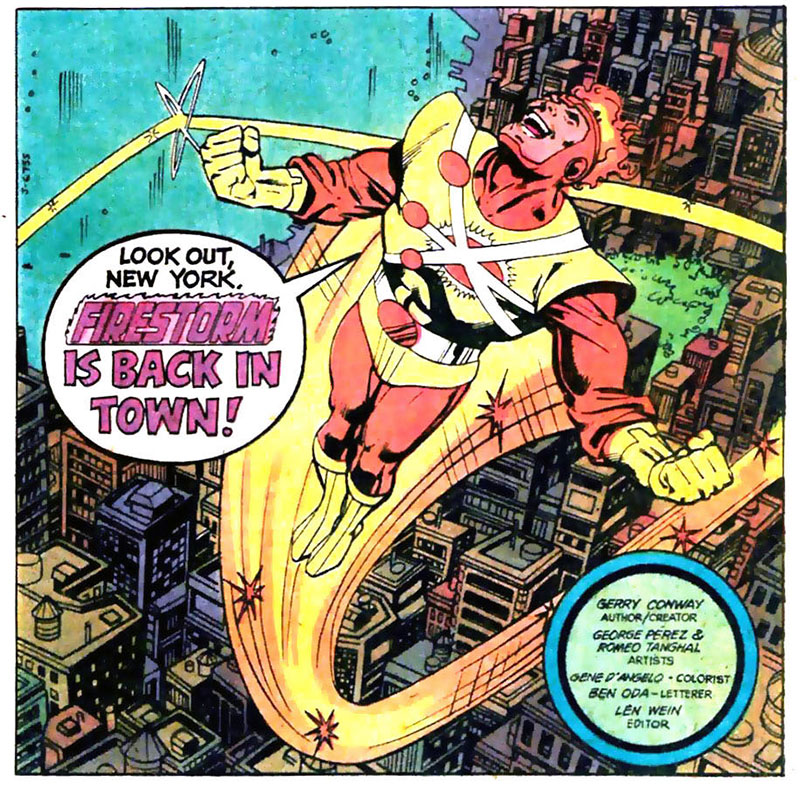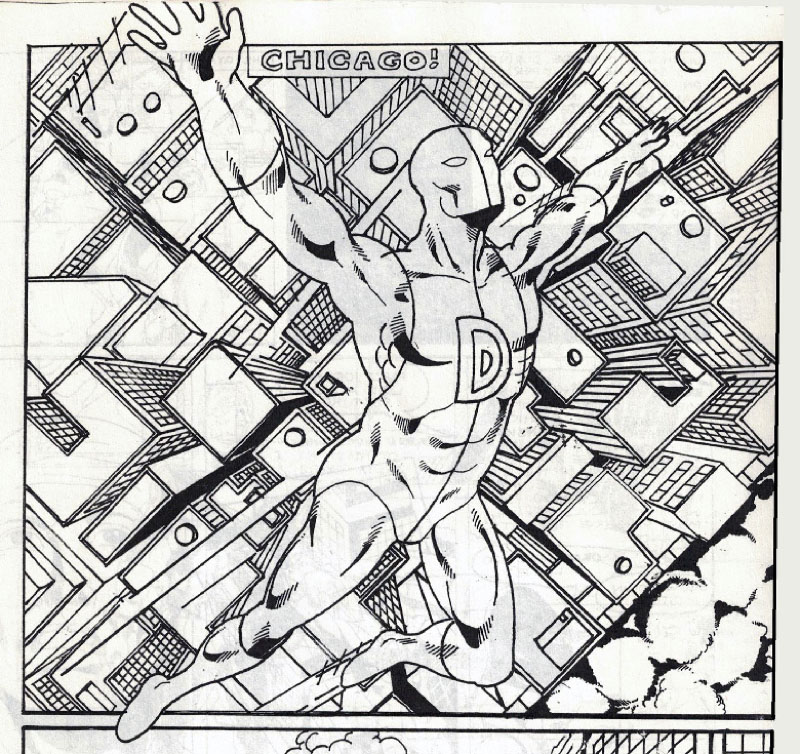Jeez, what a month of losses this has been. Personally, I’ve lost two family members and, now, two major influences in my art career: first Neal Adams back on April 28, and now George Pérez, who died of pancreatic cancer on May 6. Pérez was only 67 years old.
I was 13 years old when I first discovered Pérez’s work—on DC Comics’ dynamic (Marvel-style) superhero team comic The New Teen Titans (probably the title that Pérez is still most associated with). I was immediately taken by the energy of his dense, detailed artwork.
Talk about chops—this was a guy who drew the heck out of each page on which he worked. (And he drew thousands and thousands of pages!) When I think of his work, I picture one of those crazy, crowded city skylines, often shot directly above. Or his group fight scenes, with every character doing a specific action. Or the particular way he would draw a face in chiaroscuro, with that little spot of light under the eye on the shadowed side. He could draw crowd scenes and detail better than anyone.
Looking at his work now, I recognize that the casual observer might not necessarily appreciate Pérez’s art; it can be stereotypical “comic-y” in its reliance on overly muscled, sometimes stiff, characters, and exaggerated “camera” angles and poses. But what set Pérez above all the hacks who emulate that same style was the passion he put into every page, his attention to detail, his devotion to craft, and his love for the form of comics.
As instantly “blocky” and recognizable as his work was, it was also refined in surprising ways. He really cared about differentiating his characters. With so many other comics artists, the basic features of the main characters were the same—without the costume or the hairstyle you might not be able to tell Robin from Kid Flash from Changeling; or Wonder Girl from Starfire from Raven. Not so with Pérez, who clearly thought about the shape of each character’s face and the proportions of their features.
And of course, he loved to draw strong women. His female superheroes looked as powerful as the men—you could believe that Wonder Woman could lift a tank or Starfire could blast through a wall with her powers.
From that moment I first saw Pérez’ art on Teen Titans, I was hooked on his style, and for many years made it my mission to track down his work, including his earlier run on The Avengers—even those backup Firestorm stories in The Flash!
And he was so damn prolific. Whereas other artists struggled to keep up with a monthly book, Pérez thrived under the heavy workload. In one stretch in 1981, he was drawing both the Teen Titans AND the Justice League—both team books with tons of characters! Not to mention that he was frequently commissioned to illustrate covers for other books (which led to me buying comics in which I had no interest just to savor his amazing cover art).
There were also the odd side projects which showed up from time to time: who remembers his awesome self-inked short stories in Pacific’s Alien Worlds #7 and Vanguard Illustrated #6? (As much as I appreciated Romeo Tanghal’s inks on Pérez in Teen Titans, I loved it when Pérez inked his own pencils—so much more detail!)
Pérez—along with John Byrne and Frank Miller—was a huge influence on my own comics work at the time. I studied Pérez’ artwork, read his interviews when I could find them, and savored the fact that he was a New York City kid like me. In high school, I drew my own superhero comics, and you can clearly see Pérez’ influences in my work of the time. (In fact, I aspired to one day draw The Teen Titans when Pérez retired!) Without his example, I would never have drawn this crazy one-point perspective cityscape in my high school comic, Blade. There are so many other examples from my comics and sketchbooks of the time of me emulating Pérez’ style—someday I’ll dig them up and display them here…
As the years went by and I went to college, still dreaming of becoming a superhero artist, I continued to follow Pérez obsessively—highlights of his work from that period include the groundbreaking limited series Crisis on Infinite Earths, his landmark work as writer/artist on Wonder Woman, and his memorable stint on The Infinity Gauntlet miniseries. (Recent movies and TV shows like Avengers: Infinity War, Wonder Woman, and Supergirl all featured adaptations of stories on which Pérez worked.)
By the mid-1990s, I was transitioning from drawing superhero comics to what I do now—making comics about real people and real life. I pretty much stopped buying superhero comics, and lost touch with Pérez’ career. I draw a different kind of comics now, but those early influences never really go away, and even nowadays I find myself thinking of his work when I draw a detailed city scene or try to find the most dynamic angle from which to frame a shot.
I never got the chance to properly meet George Pérez, or to let him know how much I loved and had learned from his work. The one time I saw him in person was at a comics convention where we crossed paths. I was already getting published in the “indy comics” world by that time, and felt self-conscious about going up and introducing myself to someone who was now in a “different camp.” Plus, he was already surrounded by admirers. I remember just standing there at the con, watching him interact with his fans and taking in the fact that we were both there at the same time.
I usually make it a policy to send “fan letters” to those who have served as “mentors from afar”—I did so with writers like Roger Zelazny, Roger Angell, and Roger Ebert (all Rogers!), and even baseball announcer Jon Miller. But I’m sad to say I never did with Pérez. The closest I came was a fan letter I wrote to—and had published in!–“Titans Tower” (the Teen Titans letter column) in 1984; I like to think that George read it…
Even though I hadn’t followed Perez’ work in recent years, I was saddened last December to hear of his cancer diagnosis. And I was amazingly touched by the letter he wrote to his colleagues and fans, where he announced that he would not be seeking treatment, and instead would be spending his last few months with his family. It turned out that this superstar artist was a brave, inspiring human being as well.
I’ll end this piece with a message for other aspiring artists: his New York Times obit mentions that when Pérez first started getting published professionally, he really struggled with rendering perspective and anatomy. It’s a testament to how hard he worked that those features later became strengths of his; a lesson that every young artist should take to heart.
Thank you, George, from me and on behalf of all those readers whose lives you enriched through your example and your work.



This is a beautifully written very informative and touching tribute to a comic artist I’d never heard about but whose strengths and contributions to the comic genre I can now appreciate and a name I will now remember.
Thanks, Josh
Thanks for reading, Nancy; your comment means a lot. XOXO